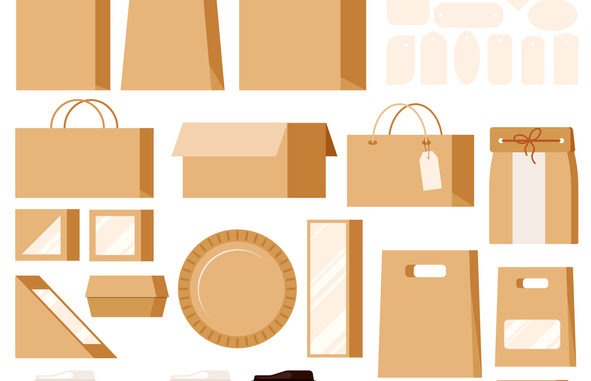
Consumer demand for more sustainable packaging is growing – and manufacturers are responding – but everyone need to ensure that the message is communicated effectively
The recent COP26 summit in Glasgow again highlighted the need to live more sustainably and reduce non-recyclable waste to try in order to mitigate the effects of climate change. However, for many people, this is already a priority; indeed, recent research by ReSociety found that 80% of consumers want to see a reduction in plastic packaging following the COVID-19 pandemic. A similar number say businesses should replace plastic with environmentally-friendly packaging across all products.
“This increased awareness is driving a consumer movement,” says Kurt Mitchell, Blake Envelopes’ sourcing and innovations manager. “Recycling rates are growing as society becomes more aware and proactive in its actions towards reducing plastic waste. People are voicing their beliefs by joining initiatives, protests and social movements to tackle plastic waste, and there is demand for progressive legislation and infrastructure to enable the responsible use of resources.”
Kurt believes that there are many ways in which packaging can be made more sustainable. “Firstly, consider the packaging and product relationship,” he says. “When choosing product packaging, ensure the packaging is the correct material and fit for the product; not only will this reduce the risk of the contents being damaged within, this also reduces the amount of emissions created during the manufacturing process.
“If you have provided sustainable packaging to your consumer, ensure that this is communicated through effective labelling and marketing that will resonate with consumers. Companies are going beyond compliance to drive action and positive consumer response, and to help ensure that packages are treated in a way that increases recovery.”
Dr Liz Wilks, EU director, sustainability, and stakeholder at APP, agrees that the communication of environmental credentials is important. “The role that sustainability and environmental awareness play in purchasing behaviour is continuing to grow, as consumers judge their favourite brands by their packaging, not just the product itself. They also expect brands to demonstrate their social and environmental responsibilities as well as those who are providing them.”
But it doesn’t stop at the packaging and the product, Liz adds. “The landscape the product is sourced from is equally important, as consumers are now also conscious of brand commitments to sustainable livelihoods and habitat conversation as well as responsible sourcing,” she says. “As a result, the industry needs to include these elements in their external communications.”
There is also evidence that consumers are willing to pay more for environmentally-friendly packaging. Liz notes that Asia Pulp & Paper’s recent Consumer Trends Report found that consumers are willing to pay more for fast food products packaged in sustainable materials, with 35% agreeing they would pay up to 10% more. “What’s clear is that consumers are searching for, and demanding, evidence that the products they are buying hold sustainability at their core.
“However, businesses risk losing out on potential revenue if they don’t promote these sustainable credentials – in fact, according to our research, 26% of consumers admit that before they purchase a product, they do not check whether it is a sustainable brand as they would not always know how to find out.
“While many brands are making sure that responsible sourcing and environmental labels such as PEFC and FSC are in place throughout their supply chain, they aren’t always communicating this effectively to their consumers.”
Abandoning plastic use
To this end, Pentel recently announced that it is moving away from plastic to 100% recyclable cardboard for its packaging. “Moving away from conventional blister cards, with their single-use plastic, is the right thing to do for the environment, but it’s not without its challenges,” says Wendy Vickery, Pentel’s marketing manager. “The obvious benefit of the plastic bubble is that it affords full product visibility to the consumer, which is a real advantage in those precious few seconds at the point of sale.”
To solve the problem of how to show products most effectively Pentel has created cardboard packs featuring an angled aperture that allows consumers to see how many products are in each pack and to identify the ink colour of products.
“For decades our office packs of loose products have been made using recycled or recyclable board. Now, we’re delighted to offer retail customers hanging packs made using board from sustainably managed woodland,” explains Wendy. “The other good news is that this important development won’t affect planograms, as our new packs are the same size as our previous blister cards.”
Paul Savill from Antalis adds that things like office paper wrappers are also becoming more recyclable. “While we can easily reference the environmental credentials of the paper with trusted certifications such as FSC and PEFC, should we not be looking at the whole product from the outside in?” he says. “The ream wrapper is an essential part of office papers make-up, with packaging designed to be visually appealing, robust enough to protect the product, and moisture-proof to ensure the paper inside remains in tip-top condition ready for use – but what consideration do we make to their recyclability?”
Paul says that the paper industry is responding, with some manufacturers producing wrappers without PE coating on certain grades which are not only recyclable via standard paper recycling bins but also biodegradable, without any detrimental effects to the moisture barrier qualities of the wrapper. “The ultimate challenge here is customer education; often, the clamour for cheap, unbranded, copier paper can result in such innovations being under-represented or misunderstood,” he says. “This education must start with the reseller engaging with their suppliers to understand fully which products and ranges meet the needs of their customers and then imparting this new knowledge to their sales teams. With this newly acquired and supported information, they will be more adept and knowledgeable in presenting customer with solutions that match their CSR policies and environmental considerations.”

Be the first to comment